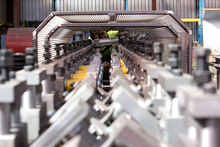Mar 21, 2014

The data indicate firms have been following through on the strong lift in investment intention recorded by surveys of business sentiment over the past year.
The pick-up in capital expenditure, with its positive implications for productivity, is one reason the Reserve Bank has revised up its estimate of the economy’s potential growth rate or “speed limit”. A migration-assisted boost to the labour force is another.
It affects the bank’s view of how much demand growth the economy can handle before inflation becomes problematic, and therefore the track of interest rates.
The December quarter recorded a 0.9 per cent rise in gross domestic product, exactly in line with market expectations. It followed a revised 1.2 per cent increase in the September quarter.
“We reckon today’s data is further ammunition to support rate hikes at each of the next three
[official cash rate reviews] as the Reserve Bank tries to get rates back to neutral as soon as possible.”It lifted economic output to a level 3.1 per cent higher than in December 2012. Statistics New Zealand’s preferred measure of annual growth, which takes the average GDP of the four quarters of 2013 and compares it with the average of the four quarters of 2012, was 2.7 per cent.
It compares with quarterly growth rates of 0.8 per cent in Australia, 0.7 per cent in Britain and 0.6 per cent in the United States.
The largest positive contribution was from manufacturing, up 2.1 per cent on the September quarter to its highest level since March 2006, despite declines in dairy and meat processing.
Agricultural output fell 1.6 per cent (seasonally adjusted) after a 13.3 per cent surge in the previous quarter. The 20 per cent rise in dairy exports came out of inventories. Mining activity was up 9.5 per cent, driven by oil and gas exploration.
Construction activity was up 0.4 per cent in the quarter to be 7.6 per cent up on December 2012.
The services sector, which makes up nearly two-thirds of the economy, grew 0.3 per cent in the quarter making 2.4 per cent for the year.
On the expenditure side of the accounts, the big driver of domestic demand was a 1.3 per cent rise in household consumption spending. Bank of New Zealand head of research Stephen Toplis said the 3.7 per cent rise in private consumption since the December 2012 quarter would be concerning to the Reserve Bank, “especially as there is now the first suggestion that household savings rates may again be falling”.
“It is this behaviour that the central bank will intend to impact most when it raises interest rates,” Toplis said.
“We reckon today’s data is further ammunition to support rate hikes at each of the next three [official cash rate reviews] as the Reserve Bank tries to get rates back to neutral as soon as possible.”
The December GDP numbers were yet further evidence of an economy that, for now a least, is sitting in a sweet spot but a sweet spot that must surely be accompanied by rising interest rates and a currency at levels that many would find unwelcome, Toplis said. It was heartening that the kiwi fell after the GDP data were released, he said, as it was further evidence that the New Zealand good news story is well priced into the market.
By Brian Fallow
